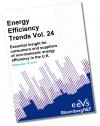In This Issue
Establishing Measurement Boundaries in M&V Projects - (Part I)
Non-Energy Benefits Gained from Implementation of ISO 50001 at the Vardar Dolomit Gostivar Facility
Survey Shows Positive M&V Trend in the UK
Increasing Energy Efficiency Investments Through Quality Assurance Schemes
October 2018 - M&V Focus Issue # 3
In this issue, Kevin Warren, the chair of EVO’s IPMVP sub-committee on EM&V provides additional insights on deemed savings in response to a previous article on this topic published in the June 2018 issue of M&V Focus. We also present part 1 of a two-part article on measurement boundaries in M&V projects. This article prepared by Agenor Garcia and Bruce Rowse explores the concept of the measurement boundary and its impact on independent variables, static factors and interactive effects in an M&V project. Zlatko Gjrchinoski is sharing a field experience on non-energy benefits gained from the implementation of an energy management system at the Vardar Dolomit Gostivar Facility. Nick Keegan reports on industry survey results showing that good M&V practices are on a positive trend in the UK. Finally, Geert Goorden outlines the framework of the QualitEE project and shows how quality assurance schemes and M&V in buildings could potentially increase investment in energy efficiency.
The Important Role of Deemed Savings in the Planning, Tracking, and Evaluation of Energy Efficiency Programs

By Kevin Warren*
This article is in response to Denis Tanguay’s article published in the last issue of M&V Focus and titled “The Exact Science of Deemed Savings.” Denis’ primary point was that energy efficiency investments, including those supported by ratepayers or taxpayers, should be evaluated. We should not look just at the money spent. We should also not simply stipulate or “deem” the savings that were achieved. I agree wholeheartedly with this.
Establishing Measurement Boundaries in M&V Projects - (Part I)

By Agenor Garcia* and Bruce Rowse**
This paper aims to explore in detail the concept of the measurement boundary, and how this affects the identification of independent variables, static factors and interactive effects in an M&V project. We review the basic IPMVP concepts and definitions of the IPMVP (from IPMVP Core Concepts, 2016), which, if incorrectly applied, can lead to various problems.
Non-Energy Benefits Gained from Implementation of ISO 50001 at the Vardar Dolomit Gostivar Facility

By Zlatko Gjrchinoski*
Anyone whose job is directly or indirectly related to energy either knows or at least should know about ISO 50001, the ISO standard for Energy Management Systems (EnMS). Some of the aims of an EnMS in line with ISO 50001 are the improvements of energy performances, the reduction of energy usage and costs, as well as the compliance with legal and other requirements.
Survey Shows Positive M&V Trend in the UK

By Nick Keegan*
Since 2012, EEVS Insight and Bloomberg NEF have been surveying the views of UK energy efficiency suppliers and consumers produce the quarterly Energy Efficiency Trends report. The most recent survey (Q2 2018) showed that over 60% of respondents are reporting use of ‘good practice’ performance measurement and verification for their energy efficiency projects, which is a considerable increase on only 20% reporting this when the survey began six years ago. What’s also encouraging is that the proportion of respondents claiming they ‘don’t know’ what good practice M&V is has dropped from 45% to 19% over the same period.
Increasing Energy Efficiency Investments Through Quality Assurance Schemes

By Geert Goorden*
Earlier this year, a consortium of European companies pooled their resources together to develop quality assessment criteria and implementing quality assurance schemes for energy efficiency services in buildings. The project, QualitEE, aims to increase investment in energy efficiency in the building sector and to improve trust in energy service providers. The project is funded by the EU’s Horizon 2020 programme and aims at implementing quality assurance schemes in at least eight countries by 2020.
In the next issue of M&V Focus!

 Part 2 of "Establishing Measurement Boundaries in M&V Projects" by Agenor GARCIA and Bruce ROWSE.
Part 2 of "Establishing Measurement Boundaries in M&V Projects" by Agenor GARCIA and Bruce ROWSE.
 "Coupling Intelligent Metering with M&V" with non-intrusive load monitoring by Antoine GUBANSKI, Laura SALEZ, Christophe RODRIGUEZ et Jean-Benoit LAFOND.
"Coupling Intelligent Metering with M&V" with non-intrusive load monitoring by Antoine GUBANSKI, Laura SALEZ, Christophe RODRIGUEZ et Jean-Benoit LAFOND.




